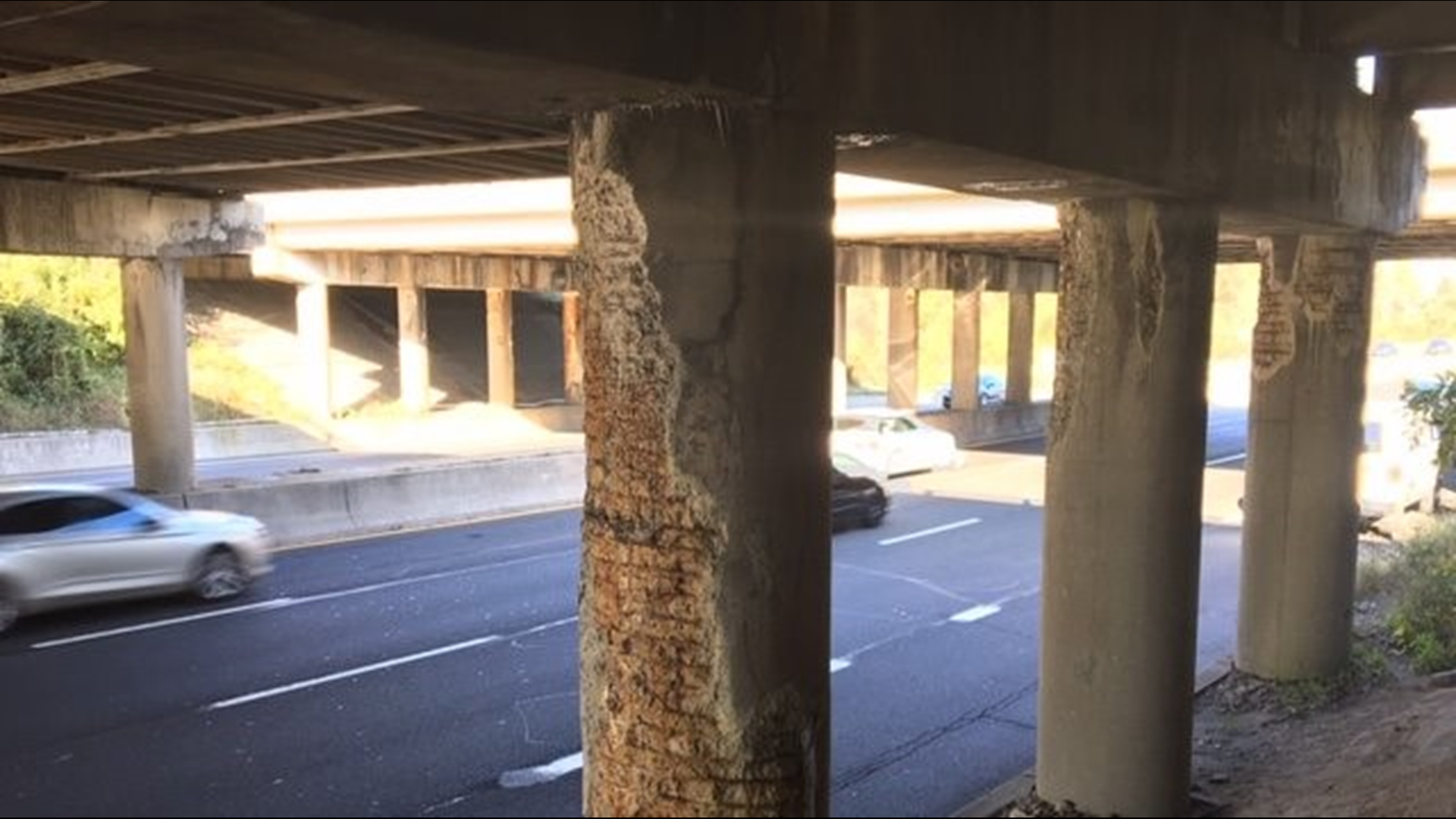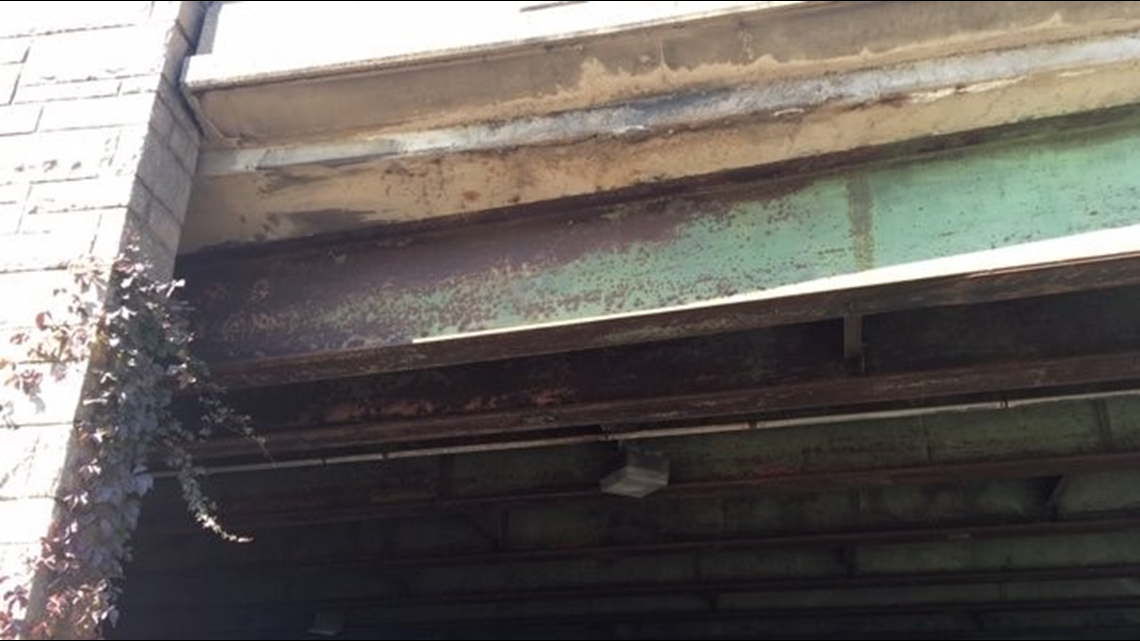67 DC-area bridges labeled as structurally deficient
Structurally deficient is a distinction that occurs when one or more elements is in poor or worse condition. The biggest culprit for many of the bridges in the area is age.

WASHINGTON -- You can’t drive anywhere in the D.C. area without crossing at least one or two bridges. They are vital to our city and in trouble. Between Maryland, D.C., and Virginia, there are 67 bridges that have been labeled structurally deficient by the Federal Highway Administration.
Structurally deficient is a distinction that occurs when one or more elements is in poor or worse condition. The biggest culprit for many of the bridges in the area is age.
“It’s like my knees, right? They were good once. And they're bad now. Why are they bad? Because I'm old,” explained Allyn Kilsheimer, a veteran structural engineer and owner of K.C.E Engineering.
Kilsheimer assessed some of the biggest structural challenges of our time. He was called into help when American Airlines Flight 77 struck the Pentagon on September 11, 2001.
There are 67 structurally deficient in counties that make up the D.C. metro.
“I got the phone call the day the plane hit. I was there for a year. Nothing will ever come close to that,” said Kilsheimer, who is also investigating the pedestrian bridge collapse at Florida International University that killed six people in March.
He knows a problem when he sees one.
"Not everything is running calculations. I do a lot of stuff by how it feels right here, “said Kilsheimer as he points to his stomach.
Kilsheimer feels many of the bridges in the D.C. area could benefit from dramatic overhauls.
“Do you see where the beam is here?” said Kilsheimer pointing to a section of a bridge that makes up the I-95/495 over Central Ave in Prince George’s County.
“See how there's a big chunk taken out of it? Well, that piece of concrete fell off.”
Interstate-95/495 over Central Ave was one of three bridges Kilsheimer, Photojournalist Rebecca Knier and Larry Miller spent two days inspecting. The bridges, labeled structurally deficient by the Federal Highway Administration, have one or more key elements in poor or worse condition.
By our count, there are 67 structurally deficient in counties that make up the D.C. metro.
We chose one bridge from Maryland, D.C., and Virginia to inspect. The bridges are some of the most traveled, structurally deficient bridges not under active construction. They include: I-95/495 over Central Ave in Prince George’s County, I-95 Route 17 in Stafford County and The Anacostia Freeway over Suitland Pkwy in D.C.
“Something needs to be done with this,” said Kilsheimer as we toured the I-95/495 over Central Ave. “Look right there, you see that piece of steel...that's kind of coming down. That part of the beam has rusted loose and broken from the rest of the beam”.


The bridges’ rusted, bruised beams appeared disfigured. Also, large concrete columns supporting the weight of the bridge were crumbling exposing steel support beams inside.
“I have grandchildren that are like 8 to 10 years old, I don't think I want them driving on top of it when they're old enough to drive,” said Kilsheimer when asked what his gut told him about the condition of the bridges that makeup I-95/495 over Central Ave.
The bridges, built in 1963, are crossed more than 203,000 times a day. We addressed our concerns with Maryland’s State Highway Administration. They acknowledge the issues and said the bridges have outlived their “useful and reliable service life.” It means we are all driving on borrowed time. State officials are in the process of replacing the bridges but the project will take three years
to finish.
“You're basing everything on what you can see. It’s usually what you can't see that's the bigger problem,” said Kilsheimer when looking at the Anacostia Freeway over the Suitland Parkway.
Built in 1964, the D.C. bridges are crossed 82,000 times a day. They suffer from corrosion, missing anchor bolts, and section loss to some of it girders.


“If you look at this, you have the concrete girder, sitting on these round columns,” said Kilsheimer inspecting the bridge. “And you'll see here, there are a bunch of hairline, spider crackings and that means there is moisture that has gotten in there and it cracks. And over a long period of time, it can expand, and it can cause rusting to the reinforcing steel. That could be a problem”.
The issues are being addressed. The District Department of Transportation said they’ve performed preventative maintenance --- with the installation of supplemental supports. Construction workers are in the process of replacing the bridge as part of the city’s South Capitol Street Project which should be completed in 2021.
We ended our trip in Virginia; inspecting the bridges that makeup I-95 over Route 17 in Stafford County.
“See the cracking of the deck,” said Kilsheimer.
“That's from water penetration. And that water rusts the steel.”


Virginia’s Department of Transportation says the bridges are regularly damaged by over height trucks hitting the girders and they’ve had to make emergency repairs to both bridge decks.
The bridge needs work but Kilsheimer doesn’t think it will collapse anytime soon. In fact, he thinks it’s the best of the three.
Virginia’s Department of Transportation tell us its being replaced. Engineers are preparing the site for construction and work should be complete four years from now.
But the worst of the three, goes to Maryland’s I-95/495 over Central Ave.
All the bridges are in the process of being replaced and transportation officials in each part of town regularly check their integrity as they race against the clock.
Even with a great deal of oversight, bridge inspectors should, “pay attention to water penetration, pay attention to cracks, seal cracks and do repairs quickly,” Kilsheimer suggested.
Top 10 Bridges by State 2018 by WUSA9 on Scribd
